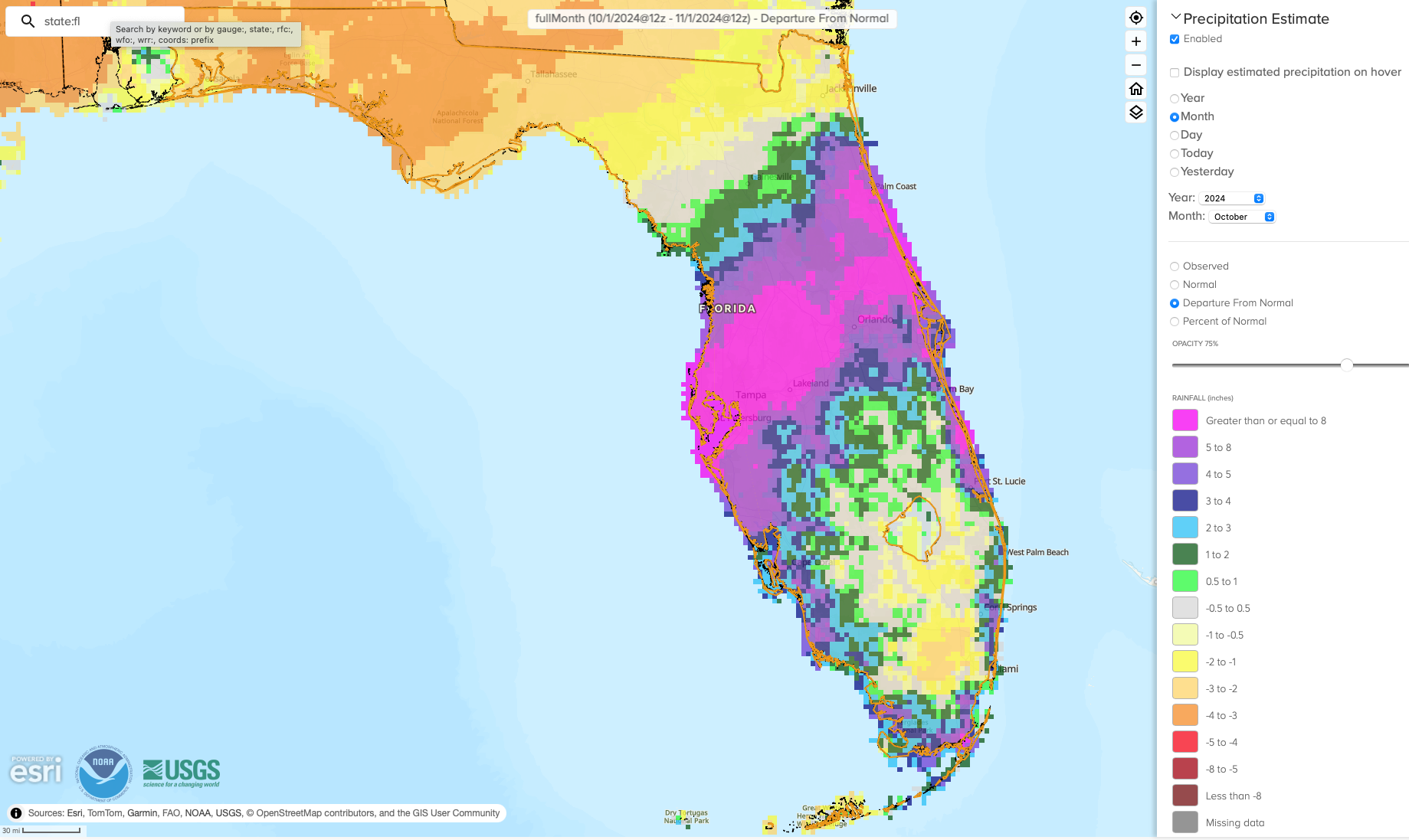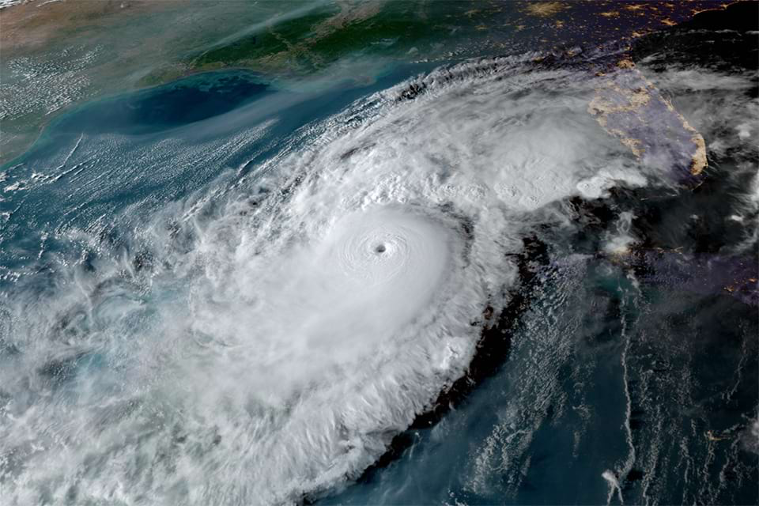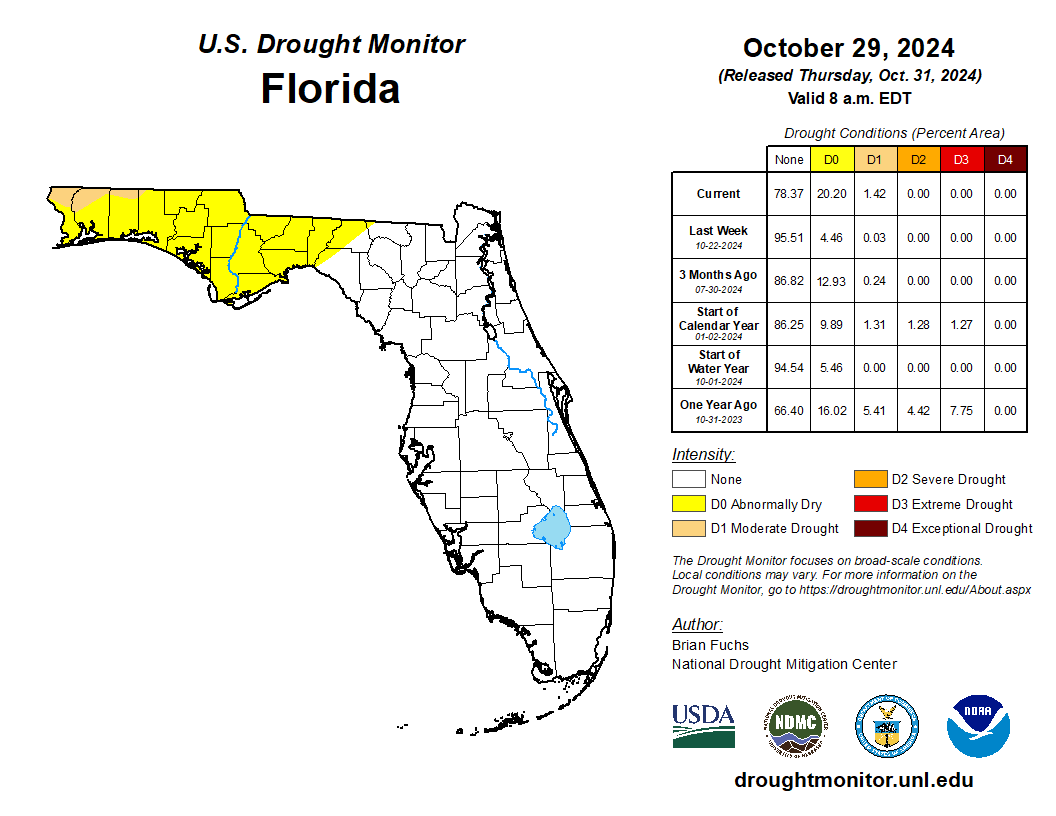Prepared by Florida Climate Center
The Florida State University
Tallahassee, FL
Summary:
- Average monthly temperatures in October were near to above normal.
- Following heavy rainfall from Hurricane Milton, the rest of October was mostly dry; monthly precipitation totals were above normal in areas impacted by Milton and below normal across the Panhandle and North Florida.
- Drying conditions across the Panhandle led to the development of abnormally dry conditions (D0) toward the end of the month.
- A transition to La Niña conditions is favored during September-November, albeit with a lower probability (60% chance); it is expected to be a weak La Niña event.
- Hurricane Milton made landfall near Siesta Key in Sarasota County on October 9 as a category 3 hurricane with peak winds of 120 mph, following on the heels of Hurricane Helene.
Average monthly temperatures in October were near to above normal in Florida. Average monthly temperature departures from normal ranged from -0.4 ̊F in Sarasota to +2.0 ̊F in Daytona Beach for the month (see Table 1 and Appendix 1 for select cities). October saw temperature swings across the state associated with upper air patterns. The month began with above normal temperatures, but a cold front impacted northern Florida and the Panhandle mid-month, bringing minimum temperatures down 8-14 degrees below normal. Minimum temperatures reached as low as 39 ̊F in Tallahassee and Chipley, and 35 ̊F in Crestview. Temperatures rebounded during the second half of the month with much warmer than normal mean temperatures across the state as a ridge of high pressure set up over the Southeast US region. Maximum temperatures were near record warm across North Florida in late October. No monthly temperature records were set but some daily temperature records were set during the month (see Appendix 2).
Table 1. October average temperatures and departures from normal ( ̊F) for selected cities.
| Station | Mean Temperature | Departure from Normal |
| Pensacola | 72.5 | +1.2 |
| Tallahassee | 71.7 | +1.4 |
| Jacksonville | 72.2 | +1.0 |
| Orlando | 76.8 | +1.3 |
| Tampa | 77.2 | -0.2 |
| Miami | 80.2 | +0.1 |
| Key West | 81.8 | +0.5 |
Monthly precipitation totals were above normal in areas impacted by Hurricane Milton and below normal across the Panhandle and North Florida. The monthly precipitation departures from normal ranged from -3.41 inches in Pensacola to +11.94 inches in Tampa (see Table 2 and Appendix 1 for select locations). The fingerprint of Hurricane Milton is clear in the October monthly rainfall departure from normal map (Figure 1), with several inches below normal rainfall in the Panhandle (orange) to greater than 8 inches across central Florida (violet). Several stations in central Florida recorded their wettest Octobers on record, including Tampa (135 years), Sarasota (113 years), Lakeland (61 years), and Sanford (76 years). This area saw surplus rainfall ranging from 9 to over 15 inches of rainfall for the month. While October is typically a dry month, the Florida Panhandle fell several inches below normal in October. Between October 4 and November 4, Panhandle communities had between 26 and 31 consecutive days with no measurable rainfall. Warmer than normal temperatures and dry weather have led to abnormally dry conditions across the western Panhandle (Figure 2).
Table 2. October precipitation totals and departures from normal (inches) for selected cities.
| Station | Total Rainfall | Departure from Normal |
| Pensacola | 1.29 | -3.41 |
| Tallahassee | 0.22 | -3.02 |
| Jacksonville | 1.85 | -2.18 |
| Orlando | 5.13 | +1.67 |
| Tampa | 14.28 | +11.94 |
| Miami | 7.50 | -0.15 |
| Key West | 3.31 | -2.36 |
Figure 1. A graphical depiction of the monthly rainfall departure from normal (inches) for October (courtesy of NOAA, NWS).

La Niña Watch.
ENSO-neutral conditions have continued in the tropical equatorial Pacific Ocean over the past month with near-average sea surface temperatures in the central and eastern equatorial Pacific Ocean. La Niña conditions are expected to emerge during September-November 2024 (60% chance) and persist through January-March 2025. The probability of La Niña is lower compared to last month, and forecasters expect a weak La Niña event. The expected weak La Niña pattern has increased the odds of below-normal precipitation for November thru February across Florida, according to the Climate Prediction Center’s seasonal outlook.
Hazardous Weather Events in October.
According to the Local Storm Reports issued by the local National Weather Service offices serving Florida, there were 458 individual local reports of hazardous weather events recorded across the state during the month of October (see Table 4 for a breakdown by event type). The majority of reports during the month were related to Hurricane Milton, which made landfall near Siesta Key, FL on the night of October 9 as a category 3 hurricane. The storm produced flash flooding, high storm surge, and a record number of tornadoes on October 9. There was a total of 126 tornado warnings issued by NWS offices serving Florida on October 9. High storm rainfall totals over 10 inches and high hourly rainfall rates led to flash flooding and riverine flooding particularly in areas to the north of the storm’s center. Storm surge along the western Gulf coast added to damages from storm surge and coastal erosion experienced less than two weeks prior during Hurricane Helene. More on the storm is provided below.
Table 3. Breakdown of storm reports submitted in Florida during the month of October (compiled from Iowa State University/Iowa Environmental Mesonet).
| Report Type | Number of Reports |
| Heavy Rain | 97 |
| Flood | 17 |
| Flash Flood | 7 |
| Coastal Flood | 2 |
| Marine Thunderstorm Wind | 4 |
| Non-Thunderstorm Wind Gust | 43 |
| Non-Thunderstorm Wind Damage | 0 |
| Tornado/Waterspout/Funnel Cloud | 60/6/0 |
| Thunderstorm Wind Damage | 1 |
| Thunderstorm Wind Gust | 67 |
| Tropical Cylone | 144 |
| Storm Surge | 8 |
| Rip Currents | 2 |
Daily Record Events in October.
Table 4. Summary of daily records broken or set in Florida in October (source: NCEI Daily Weather Records).
| Category | Number of Records |
| Highest daily max. temp. | 32 |
| Highest daily min. temp. | 21 |
| Lowest daily max. temp. | 12 |
| Lowest daily min. temp. | 4 |
| Highest daily precipitation | 25 |
| Total | 94 |
Weather/Climate Highlights of the Month: Hurricane Milton
Hurricane Milton made landfall as a major category 3 hurricane near Siesta Key, FL in Sarasota County on the night of October 9 with sustained winds of 120 mph. Milton made landfall less than 2 weeks following Hurricane Helene, which hit the Florida Big Bend region on September 26 as a category 4 hurricane. The back-to-back storms caused compounding impacts to communities along Florida’s west coast. Milton produced damaging storm surge flooding, as well as hurricane-force winds, heavy rainfall, and a record number of tornadoes across Florida’s Peninsula. Read more about Milton and its impacts in Florida in our post-storm summary report.
Hurricane Milton on October 8, 2024, at 6:30 pm Eastern Time as captured by NOAA’s GOES-16 satellite. (Credit: NOAA)

Drought-Related Impacts.
In mid-October, about 1% of the state was experiencing abnormally dry (D0) conditions, according to the U.S. Drought Monitor. By the end of the month, moderate drought (D1) affected 1.4% of the state and about 20% of the state was abnormally dry (D0) (Figure 2 below).
As of October 31, the Lake Okeechobee water level was 16.10 ft. above sea level (Feet-NGVD29), which is above average for this time of year. At the first of the month, the water level was 15.35 ft. above sea level.
Figure 2. A graphical depiction of the latest drought conditions in Florida according to the U.S. Drought Monitor (courtesy of the National Drought Mitigation Center, University of Nebraska-Lincoln).

Agriculture-Related Impacts.
Despite back-to-back hurricanes impacting the state, little rainfall since has led to quickly deteriorating conditions in the Florida Panhandle. In mid-October, topsoil moisture conditions were adequate in 72% of the state, short in 9%, and very short in 1% of the state, while 18% of the state had surplus topsoil moisture conditions. By the end of October, topsoil moisture conditions were adequate in 62% of the state, short in 21%, and very short in 7% of the state, while 10% had surplus topsoil moisture conditions. For more information, consult the Crop Progress and Conditions report, which is published by the USDA’s National Agricultural Statistics Service.
Appendix 1
Additional October departures from normal data for select Florida locations (Source: NWS).
| Station | Average Temperature (˚F) | Departure from Normal (˚F) | Total Rainfall (in.) | Departure from Normal (in.) |
| Gainesville | 71.8 | +0.4 | 4.79 | +2.11 |
| Sarasota | 76.9 | -0.4 | 12.59 | +9.83 |
| Daytona Beach | 76.4 | +2.0 | 13.37 | +8.52 |
| Naples | 80.1 | +1.6 | 4.39 | +0.46 |
| Fort Myers | 78.7 | +0.7 | 7.16 | +4.08 |
| West Palm Beach | 79.5 | +0.8 | 9.88 | +3.98 |
Appendix 2
Select daily record high maximum temperatures (°F) tied or broken during October 2024 (compiled from NOAA).
| Location | Date | Record | Broken/Tied | Last |
| Clermont | 1 | 96 | Broken | 94 in 2019 |
| Fort Lauderdale | 1 | 93 | Broken | 92 in 2015 |
| Plant City | 1 | 101 | Broken | 98 in 1904 |
| Kissimmee | 1 | 94 | Tied | 94 in 1977 |
| Vero Beach | 1 | 92 | Broken | 91 in 1989 |
| Ochopee | 2 | 96 | Broken | 95 in 2002 |
| Naples | 2 | 93 | Tied | 93 in 2023 |
| Fort Myers | 2 | 94 | Tied | 94 in 1988 |
| Tampa | 3 | 94 | Tied | 94 in 1990 |
| Tampa | 4 | 93 | Broken | 92 in 2023 |
| Gainesville | 4 | 91 | Tied | 91 in 2019 |
| Key West | 4 | 92 | Broken | 91 in 2021 |
| Pensacola | 8 | 90 | Broken | 89 in 2019 |
| Fernandina Beach | 15 | 91 | Broken | 89 in 1925 |
| Pensacola | 24 | 87 | Broken | 86 in 1978 |
| Marianna | 25 | 90 | Broken | 89 in 2010 |
| Tallahassee | 25 | 91 | Broken | 88 in 1984 |
| Chipley | 26 | 90 | Tied | 90 in 1939 |
| Fernandina Beach | 26 | 88 | Broken | 86 in 1963 |
| Crestview | 26 | 88 | Broken | 87 in 2020 |
| Tallahassee | 26 | 91 | Broken | 88 in 1984 |
| Tallahassee | 27 | 90 | Broken | 89 in 1984 |
| Niceville | 28 | 88 | Broken | 85 in 1984 |
| Fernandina Beach | 30 | 89 | Broken | 87 in 1922 |


